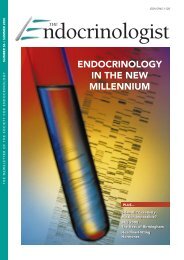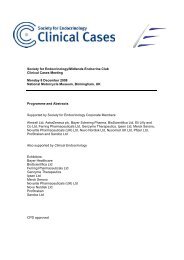Standards for undergraduate medical education - Society for ...
Standards for undergraduate medical education - Society for ...
Standards for undergraduate medical education - Society for ...
Create successful ePaper yourself
Turn your PDF publications into a flip-book with our unique Google optimized e-Paper software.
Hypogonadism – an endocrine issue which causes significant morbidity and substantial reduction in quality of life 1<br />
Ccontrol<br />
concentration<br />
cost<br />
Cconvenience<br />
Tostran ® – a simple solution to a serious problem<br />
Control<br />
• Tostran ® returns and maintains hypogonadal patients T levels to normal 2<br />
• The metered dose system allows <strong>for</strong> easy dose titration<br />
Concentration<br />
• Tostran ® is the only 2% testosterone gel<br />
Cost<br />
• Tostran ® represents a 14% cost saving compared to Testogel ® at the lowest<br />
and highest approved doses 3,4<br />
Convenience<br />
• Tostran ® – easy to use, metered dose canister 5<br />
The first metered dose<br />
2% testosterone ge l<br />
A simple solution to a serious problem<br />
Tostran Abbreviated Prescribing In<strong>for</strong>mation<br />
Tostran (testosterone) 2% Gel Prescribing In<strong>for</strong>mation<br />
Please refer to Summary of Product Characteristics (SPC) be<strong>for</strong>e prescribing.<br />
Presentation<br />
Tostran 2% Gel, contains testosterone, 20 mg/g.<br />
Indications<br />
Replacement therapy with testosterone <strong>for</strong> male hypogonadism when<br />
testosterone deficiency has been confirmed by clinical symptoms and laboratory<br />
analyses.<br />
Posology<br />
The starting dose is 3 g gel (60 mg testosterone) applied once daily at<br />
approximately the same time each morning to clean, dry, intact skin, alternately<br />
on the abdomen or to both inner thighs. Adjust dose according to clinical and<br />
laboratory responses. Do not exceed 4 g of gel (80 mg testosterone) daily.<br />
Patients who wash in the morning should apply Tostran after washing, bathing<br />
or showering. Do not apply to the genitals. Do not use in women, or children<br />
under the age of 18 years.<br />
Contraindications<br />
Known or suspected carcinoma of the breast or the prostate; hypersensitivity to<br />
any of the ingredients.<br />
Special warnings and precautions <strong>for</strong> use<br />
Tostran should not be used to treat non-specific symptoms suggestive of<br />
hypogonadism if testosterone deficiency has not been demonstrated and if<br />
other aetiologies responsible <strong>for</strong> the symptoms have not been excluded. Not<br />
indicated <strong>for</strong> treatment of male sterility or sexual impotence. All patients<br />
must be pre-examined to exclude a risk of pre-existing prostatic cancer.<br />
Per<strong>for</strong>m careful and regular monitoring of breast and prostate. Androgens<br />
may accelerate the development of subclinical prostatic cancer and benign<br />
prostatic hyperplasia. Oedema with/without congestive heart failure may be<br />
a serious complication in patients with pre-existing cardiac, renal or hepatic<br />
disease. Discontinue immediately if such complications occur. Use with caution<br />
in hypertension as testosterone may raise blood pressure. Use with caution in<br />
ischemic heart disease, epilepsy, migraine and sleep apnoea as these conditions<br />
may be aggravated. Care should be taken with skeletal metastases due to risk<br />
of hypercalcaemia/hypercalcuria. Androgen treatment may result in improved<br />
insulin sensitivity. In<strong>for</strong>m the patient about the risk of testosterone transfer<br />
and give safety instructions. Health professionals/carers should use disposable<br />
gloves resistant to alcohols.<br />
Interactions<br />
When androgens are given simultaneously with anticoagulants, the<br />
anticoagulant effect can increase and patients require close monitoring of their<br />
INR. Concurrent administration with ACTH or corticosteroids may increase the<br />
likelihood of oedema and caution should be exercised.<br />
Undesirable effects<br />
Very common (1/10): application site reactions (including paresthesia,<br />
xerosis, pruritis, rash or erythema); common (1/100,


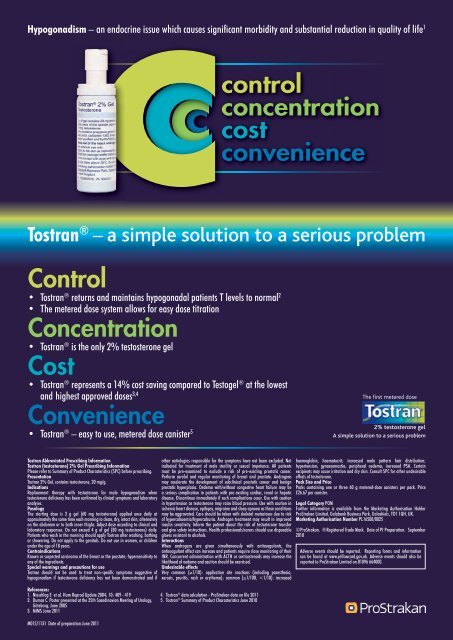
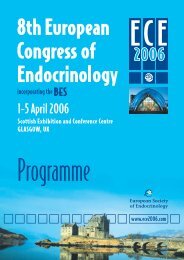
![The Endocrinologist | Issue 99 [PDF] - Society for Endocrinology](https://img.yumpu.com/48213777/1/184x260/the-endocrinologist-issue-99-pdf-society-for-endocrinology.jpg?quality=85)

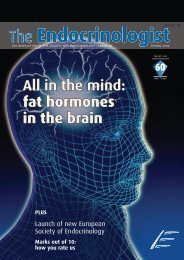
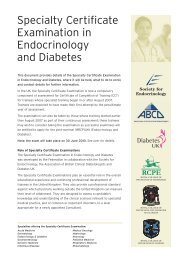

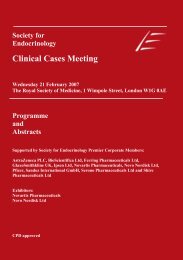

![The Endocrinologist | Issue 97 [PDF] - Society for Endocrinology](https://img.yumpu.com/40840065/1/184x260/the-endocrinologist-issue-97-pdf-society-for-endocrinology.jpg?quality=85)

